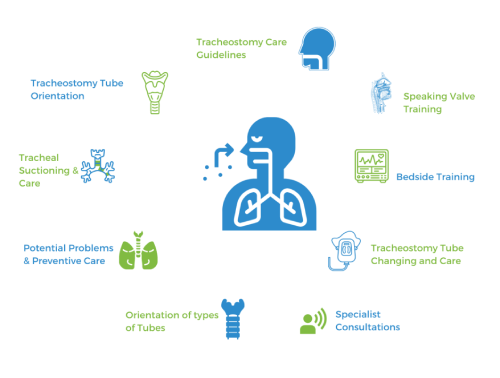What is Tracheostomy ?
Tracheostomy is a medical procedure which involves creating an opening (stoma) in the neck in order to place a tube into a person’s windpipe (Trachea).
A specially designed tracheostomy tube is inserted through the opening in the neck below the vocal cords which allows air to enter the lungs bypassing the nasal and oral passage. It also helps in clearing the secretions from the airway.

When And Who Will Need Tracheostomy ?
Three Main Reasons for Tracheostomy Are:
Why Tracheostomy Is Done ?
Situations that may call for a tracheostomy include:
How it Works ?
A tracheostomy provides an air passage to help you breathe when the normal airway is partially or completely blocked.
Decanulation:
When a tracheostomy is no longer needed, the tube is replaced with a smaller size tube, and then gradually removed. The stoma is allowed to heal and close. For some people, a tracheostomy is permanent.
Complications of long term tracheostomy:
If a patient needs to retain a tracheostomy after discharge from hospital, regular follow-up is needed for monitoring possible complications.
Care of Tracheostomy Tube
Care Of Tracheostomy Site
Change the dressing/Gauze piece kept around the tube daily and as and when it is dirty or wet. This will help in keeping the stoma clean, dry and healthy.
Coping With Dry Air
As the air is not passing through normal airway, the air may be comparatively dry which can cause irritation, cough and excess mucus coming out of tracheostomy. Using a thermovent and regular nebulization may help.
Speaking
As the exhaled air bypasses the vocal cords, speaking is difficult with tracheostomy .But there are devices and techniques to produce voice. Skilled nurses and speech therapist will assist in learning to speak again.
Eating
Depending on the severity of illness, patient will be nourished on IV fluids, Tube feeding etc. Initally swallowing is difficult. As the wound heals and patient is ready to eat again, a speech and swallow therapist or skilled nurse will assess the patient, help to regain muscle strength and coordination for swallowing.
Signs and Symptoms of Blocked Tracheostomy
Immediate Management


